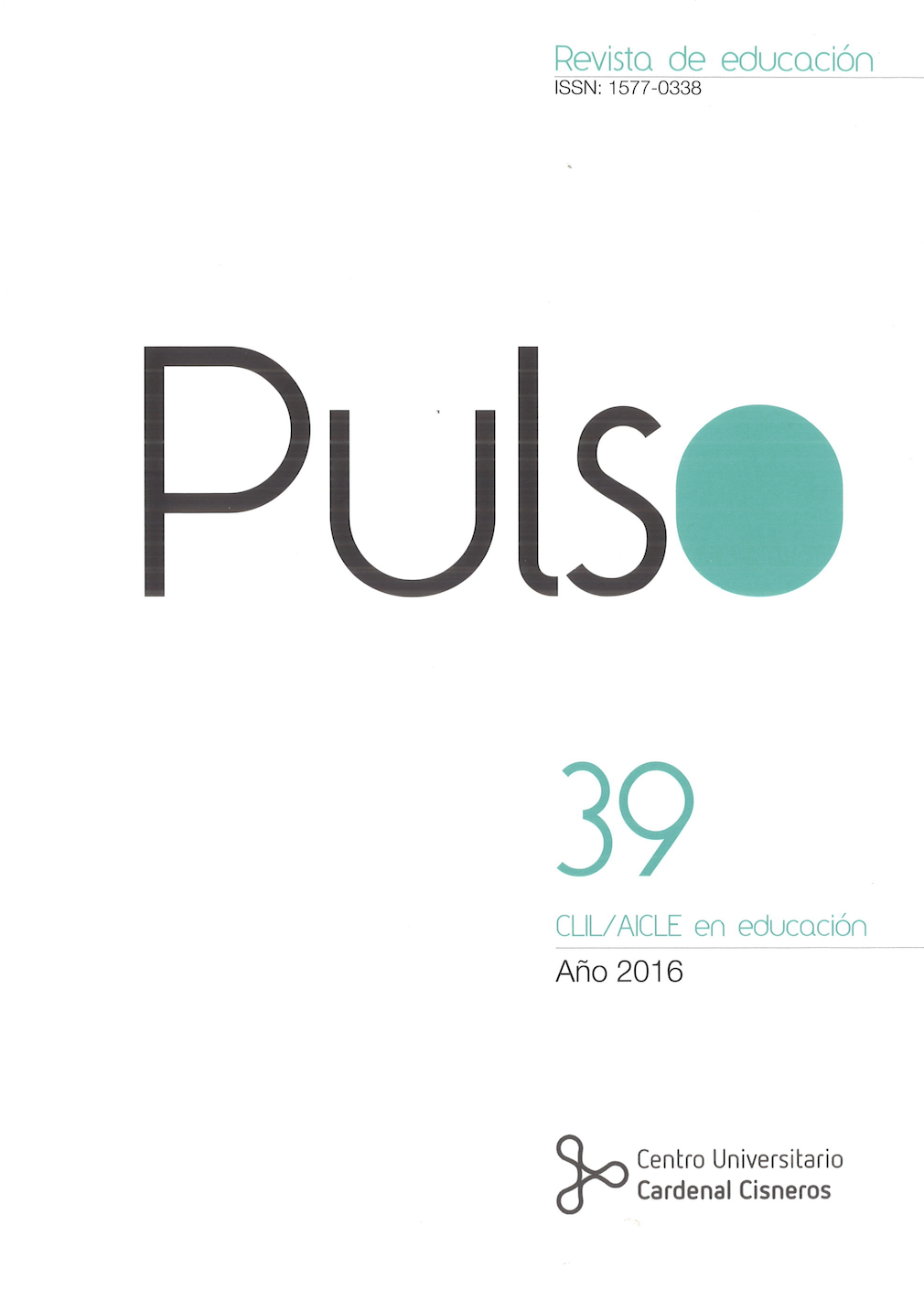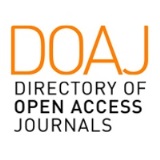Promoting reading skills in CLIL
DOI:
https://doi.org/10.58265/pulso.5079Palabras clave:
AICLE, Habilidades Lectoras, PropuestasResumen
El aprendizaje integrado de contenido y lenguas extranjeras (AICLE) ha sido ampliamente implementado en nuestras instituciones educativas a través de diferentes enfoques. AICLE puede incluir una gran variedad de recursos de enseñanza pero este nuevo marco debe implicar una perspectiva innovadora que supere las restricciones del curriculum tradicional. La lectura es un proceso complejo que implica diferentes habilidades y estrategias. En el Marco Común Europeo de Referencia, está considerada como elemento clave en el proceso de aprendizaje de una lengua. Fomentar la comprensión lectora es también esencial en el enfoque AICLE (Wolff, 2005). Aunque la lectura ha sido considerada como una de las habilidades más importantes en la metodología AICLE, pocos estudios han centrado su atención en los resultados de la lectura en AICLE (Pérez Cañado, 2012). La primera parte de este artículo presenta un marco teórico general sobre la lectura en AICLE destacando sus principales características, potencial y ventajas en el aula. La segunda parte del artículo ofrece una serie de directrices para una implementación efectiva de actividades de lectura en los programas AICLE a través de diferentes ejemplos.
Descargas
Citas
Aebersold, J., & Field, M. (1997). From reader to reading teacher: Issues and strategies for second language classrooms. Cambridge: Cambridge University Press.
Alderson, J. C. (1984). Reading in a foreign language: a reading problem or a language problem? In Alderson, J. C. and Urquhart, A. H. (Eds.), Reading in a Foreign Language, (pp. 1-27). London: Longman.
Anderson, N. J. (2003). Strategy research and training: Special issue. TESL-EJ, 7/2, 1-20.
Anderson, R., and Pearson, P. (1984). A schema-theoretic view of basic processes in reading comprehension. In Pearson, P. D. (Ed.), Handbook of reading research, (pp. 255-291). New York, NY: Longman.
Anmarkrud, Ø., & Refsahl, V. (2010). Gode lesestrategier - på mellomtrinnet. Oslo: Cappelen Akademisk Forlag.
Bamford, J. and Day, R. R. (2004). Extensive Reading Activities for Teaching Language. Cambridge: Cambridge University Press.
Bell, T. (1998). Extensive Reading: Why? and How? The Internet TESL Journal 4/12. Retrieved from http://iteslj.org/Articles/Bell-Reading.html.
Bernhardt, E. B. (1991). Reading development in a second language: Theoretical, research and classroom perspectives. Norwood, NJ: Ablex.
Bernhardt, E. B. (2011). Understanding Advanced Second-Language Reading. New York and London: Routledge.
Bernhardt, E. B., and Kamil, M. L. (1995). Interpreting Relationships between L1 and L2 Reading: Consolidating the Linguistic Threshold and the Linguistic Interdependence Hypotheses. Applied Linguistics, 16/1, 15-34.
Bråten, I. (2007). Leseforståelse. Lesing i kunnskapssamfunnet - teori og praksis. Oslo: Cappelen Akademisk Forlag.
Brinton, D. M., Snow, M. A., & Wesche, M. B. (1989). Content-Based Second Language Instruction. New York: Newbury House
Brown, A., and Palincsar, A. (1984). Reciprocal teaching of comprehension-fostering and comprehension monitoring activities. Cognition and Instruction, 1/2, 117-175.
Dafouz, E., Guerrini, M. (eds.) (2009). CLIL Across Educational Levels: Experiences from Primary, Secondary and Tertiary Contexts. Madrid: Santillana
Dakowska, M. (2005). Teaching English as a Foreign Language. Warszawa: Wydawnictwo Naukowe Pwn.
Day, R. R. and Bamford, J. (1998). Extensive Reading in the Second Language Classroom. Cambridge: Cambridge University Press.
Elley, W. B., & Mangubhai, F. (1983). The impact of reading on second language learning. Reading Research Quarterly, 19, 53–67.
Fernández Fontecha, A. (2009). “Spanish CLIL: Research and official actions”. In Y. Ruiz de Zarobe and R. M. Jiménez Catalán (eds.), Content and Language Integrated Learning. Evidence from Research in Europe. Bristol: Multilingual Matters,3-21.
García-Laborda, J., Bejarano, L. G., Simons, M. (2012). ¿Cuánto aprendí en la enseñanza secundaria? Las actitudes de los estudiantes universitarios de primer año respecto a la relación enseñanza-aprendizaje de su segunda lengua en la escuela secundaria en tres contextos internacionales. Educación XXI, 15, 159-184.
Goodman, K. S. (1967). Reading: A psycholinguistic guessing game. Journal of the Reading Specialist, 6, 126-135.
Grabe, W. (2009). Reading in a Second Language. Moving from Theory to Practice. Cambridge: Cambridge University Press.
Grabe, W., and Stoller, F. (2002). Teaching and researching reading. Harlow: Pearson Education.
Hafiz, F., & Tudor, I. (1989). Extensive reading and the development of language skills. English Language Teaching Journal, 43, 4–11.
Hellekjær, G. O. (1996). Easy does it: Introducing Pupils to Bilingual Instruction. Språk og språkundervisning, 3, 9-14.
Hellekjær, G. O. (2005). The Acid Test: Does Upper Secondary EFL Instruction Effectively Prepare Norwegian Students for the Reading of English Textbooks at Colleges and Universities? (Doctoral dissertation). Oslo: University of Oslo.
Hellekjær, G. O. (2008). A Case of Improved Reading Instruction for Academic English Reading Proficiency. Acta Didactica Norge, 2, 1-17.
Hillocks, Jr. G. (1987). Synthesis of research on teaching writing. Educational Leadership, 44/8, 71-82.
Horst, M. (2005). Learning L2 vocabulary through extensive reading: A measurement study. The Canadian Modern Language Review, 61, 355–382.
Ioannou-Georgiou, S. and Pavlos P. (2011). Guidelines for CLIL implementation in Primary and Pre-Primary Education. ProCLIL.
Khaki, Nasrin. (2014). Improving reading comprehension in a foreign language: Strategic reader. The Reading Matrix, 14/2, 186-200. Retrieved from http://www.readingmatrix.com/files/11-m9371u67.pdf
Kintsch, W. (2005). An overview of top-down and bottom-up effects in comprehension: The CI perspective. Discourse Processes, 39/2-3, 125-128.
Koda, K. (2004). Insights into Second Language Reading. A Cross-Linguistic Approach. Cambridge: Cambridge University Press.
Lasagabaster, D. and Ruiz de Zarobe, Y. (2010). CLIL in Spain: Implementation, Results and Teacher Training. Newcastle upon Tyne: Cambridge Scholars Publishing.
Loranc-Paszylk, B. (2009). Integrating Reading and Writing into the Context of CLIL Classroom: Some Practical Solutions. International CLIL Research Journal, 1/2, 47-53.
Lorenzo, F. (2010). CLIL in Andalusia. In Lasagabaster, D. and Ruiz de Zarobe, Y. (Eds.). CLIL in Spain: Implementation, Results and Teacher Training (pp. 2-12). Newcastle upon Tyne: Cambridge Scholars Publishing.
Macaro, E. (2006). Strategies for language learning and for language use: Revising the theoretical framework. The Modern Language Journal, 90, 320-337.
MacIntyre, P. D. (1994). Toward a social psychological model of strategy use. Foreign Language Annals, 27, 185-195.
Mason, B. & Krashen, S. (1997). Extensive reading in English as a foreign language. System, 25, 91–102.
McDonough, S. (1999). Learner strategies. Language Teaching Research, 32, 1-18.
O’Malley, J. M., and Chamot, A. U. (1990). Learning strategies in second language acquisition. Cambridge: Cambridge University Press.
Papaja, K. (2014). Focus on CLIL: A Qualitative Evaluation of Content and Language Integrated Learning (CLIL) in Polish Secondary Education.
Newcastle upon Tyne: Cambridge Scholars Publishing.
Pérez-Cañado, M. L. (2012). CLIL Research in Europe: Past, Present, and Future. International Journal of Bilingual Education and Bilingualism, 15/3, 315-341.
Pigada, M., & Schmitt, N. (2006). Vocabulary acquisition from extensive reading: A case study. Reading in a Foreign Language, 18, 1–28.
Ruiz de Zarobe, Y. and Jiménez, R. (2009). Content and Language Integrated Learning (CLIL): Evidence from Research in Europe. Clevendon: Multilingual Matters.
Sánchez Ruiz, R. (2011). La comprensión lectora en Inglés: problemas encontrados en las pruebas de acceso a la universidad”.ENSAYOS, Revista de la Facultad de Educación de Albacete 26. Retrived from http://www.uclm.es/ab/educacion/ensayos
Skogen, M. (2013). Reading in CLIL and in regular EFL classes: to what extent do they differ in reading proficiency and strategy use? Oslo: University of Oslo.
Smith, F. (1982). Understanding reading: A psycholinguistic analysis of reading and learning to read. New York: Holt, Rinehart and Winston.
Tsang, W. (1996). Comparing the effects of reading and writing on writing performance. Applied Linguistics, 17, 210–233.
Wolff, D. (2005). Approaching CLIL. Project D3 - CLIL Matrix - Central workshop report 6/2005, 10-25. Recovered from http://www.ecml.at
Yang, A. (2001). Reading and the non-academic learner: A mystery solved. System, 29, 451–466.
Descargas
Publicado
Cómo citar
Número
Sección
Licencia
Derechos de autor 2022 Pulso. Revista de educación

Esta obra está bajo una licencia internacional Creative Commons Reconocimiento-NoComercial-SinObraDerivada 3.0.
Esta revista proporciona un acceso abierto inmediato a su contenido, basado en el principio de que ofrecer al público un acceso libre a las investigaciones ayuda a un mayor intercambio global de conocimiento.
Las obras se publican en la edición electrónica de la revista bajo una licencia Creative Commons Reconocimiento-NoComercial-SinObraDerivada 4.0
Se permite y se anima a los autores a difundir electrónicamente la versión post-print (versión evaluada y aceptada para su publicación) de sus obras antes de su publicación, ya que favorece su circulación y difusión más temprana y con ello un posible aumento en su citación y alcance entre la comunidad académica.














